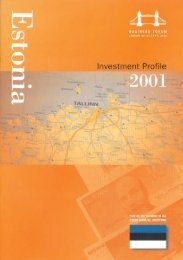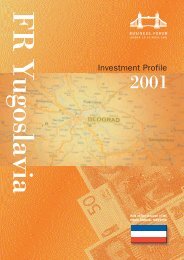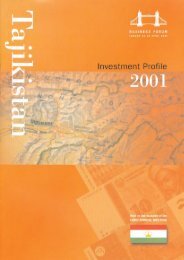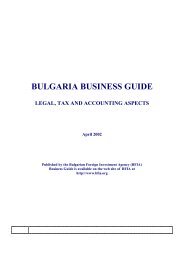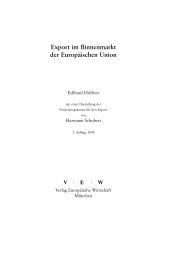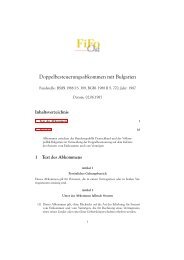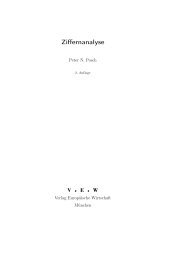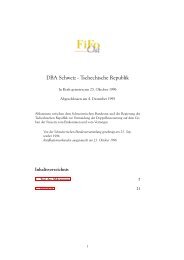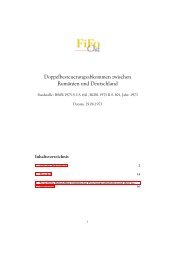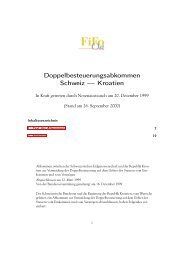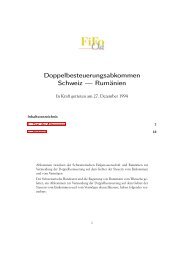EBRD activities in Ukraine - FiFo Ost
EBRD activities in Ukraine - FiFo Ost
EBRD activities in Ukraine - FiFo Ost
You also want an ePaper? Increase the reach of your titles
YUMPU automatically turns print PDFs into web optimized ePapers that Google loves.
Introduction<br />
F<strong>in</strong>ancial sector<br />
Bank<strong>in</strong>g consolidation<br />
Fragmentation has been a major concern for the NBU, ow<strong>in</strong>g<br />
to the result<strong>in</strong>g lack of risk diversification and supervis<strong>in</strong>g<br />
difficulties. A gradual process of consolidation is under way.<br />
More mergers and more effective procedures by the NBU for<br />
the liquidation of banks contributed to a decl<strong>in</strong>e <strong>in</strong> the number<br />
of banks from 205 (total) at the end of 1999 to 153 (licensed)<br />
banks at the end of 2000. The new bank<strong>in</strong>g law <strong>in</strong>corporates<br />
<strong>in</strong>ternational experience and provides for <strong>in</strong>creased NBU<br />
regulatory framework powers. The president has acknowledged<br />
the importance of develop<strong>in</strong>g the sector. These developments<br />
could lead to a more rapid consolidation through a more<br />
determ<strong>in</strong>ed enforcement of licens<strong>in</strong>g and other regulations.<br />
In 2000, six out of 38 commercial banks were closed, which had<br />
been registered as be<strong>in</strong>g <strong>in</strong> a state of liquidation s<strong>in</strong>ce 1994.<br />
Ukra<strong>in</strong>e Micro F<strong>in</strong>ance Bank (MFB)<br />
In early 2001 the Ukra<strong>in</strong>e Micro F<strong>in</strong>ance Bank (MFB) started<br />
operations, the only newly registered bank <strong>in</strong> Ukra<strong>in</strong>e dur<strong>in</strong>g the<br />
last two years. MFB provides f<strong>in</strong>ancial services to Ukra<strong>in</strong>ian private<br />
micro enterprises. Shareholders <strong>in</strong>clude the <strong>EBRD</strong> (20 per cent),<br />
the IFC (20 per cent), the German-Ukra<strong>in</strong>ian Fund (20 per cent),<br />
the Western NIS Enterprise Fund (20 per cent), IMI (Germany,<br />
10 per cent) and DOEN (Netherlands, 10 per cent). In addition<br />
to their € 10 million equity contribution, the shareholders will<br />
provide debt f<strong>in</strong>ance, <strong>in</strong>clud<strong>in</strong>g an <strong>EBRD</strong> credit l<strong>in</strong>e of up to<br />
€ 10 million. MFB is offer<strong>in</strong>g loans of up to US$ 125,000 <strong>in</strong><br />
foreign currency, and smaller loan amounts are provided <strong>in</strong> local<br />
currency. The bank also providesother bank<strong>in</strong>g services such as<br />
deposit and current accounts, money transfer and <strong>in</strong>ternational<br />
payments. MFB is currently operat<strong>in</strong>g <strong>in</strong> Kyiv and Slavutych, but<br />
will soon open branches <strong>in</strong> Kharkiv, Donetsk and Lviv.<br />
Foreign <strong>in</strong>vestment <strong>in</strong> the bank<strong>in</strong>g sector<br />
Ukra<strong>in</strong>e has one of the most liberal sets of regulations for<br />
foreign bank participation <strong>in</strong> the CIS. Foreigners are permitted<br />
to participate fully <strong>in</strong> the domestic bank<strong>in</strong>g sector, although<br />
they must establish a resident office a year before apply<strong>in</strong>g for<br />
a licence. Of the total 31 banks with foreign capital, only seven<br />
are 100 per cent foreign-owned. While foreign penetration is<br />
26 Ukra<strong>in</strong>e Investment Profile<br />
tak<strong>in</strong>g place, it rema<strong>in</strong>s slow. On 1 January 2001, foreign<br />
capital accounted for 14.47 per cent of the Ukra<strong>in</strong>ian bank<strong>in</strong>g<br />
system, but only for 5 per cent of the bank<strong>in</strong>g sector assets.<br />
Foreign banks service both their mult<strong>in</strong>ational clients and<br />
Ukra<strong>in</strong>ian blue chips. S<strong>in</strong>ce 1997 foreign banks such as Credit<br />
Lyonnais (France), Raiffeisenbank (Austria), ING (Netherlands),<br />
Kreditanstalt (Germany) and Citibank (US) have established full<br />
subsidiaries. Apart from western banks, banks from<br />
neighbour<strong>in</strong>g countries such as Russia (Alfa Bank, National<br />
Reserve Bank) and Poland (Kredyt Bank, PEKAO) are also<br />
enter<strong>in</strong>g the market.<br />
Non-bank f<strong>in</strong>ancial <strong>in</strong>stitutions<br />
Securities<br />
The Ukra<strong>in</strong>ian securities market, which was created ma<strong>in</strong>ly to<br />
facilitate post-privatisation enterprise restructur<strong>in</strong>g <strong>in</strong> the early<br />
1990s, has gradually evolved to feature more or less the same<br />
range of <strong>in</strong>stitutions and <strong>in</strong>struments as more developed<br />
markets. However, the securities markets are still underdeveloped<br />
and over-regulated, not transparent and ma<strong>in</strong>ly<br />
markets for consolidation of “strategic” enterprises. The Law<br />
on Securities and the Stock Exchange (1991) provides for the<br />
use of such <strong>in</strong>struments as shares, municipal bonds,<br />
corporate bonds, treasury bills, sav<strong>in</strong>g certificates, promissory<br />
notes and privatisation papers. In 1996, new regulations<br />
(On State Regulation of the Securities Market <strong>in</strong> Ukra<strong>in</strong>e)<br />
established the State Securities and Stock Market<br />
Commission (SSMSC), with adm<strong>in</strong>istrative and discipl<strong>in</strong>ary<br />
powers over brokers and trad<strong>in</strong>g <strong>activities</strong>. The Law On the<br />
National Depository System and Electronic Circulation of<br />
Securities was adopted <strong>in</strong> 1997. In 1999, the SSMSC<br />
tightened controls on so-called “non-organised” trad<strong>in</strong>g, aimed<br />
at improv<strong>in</strong>g transparency on the market. While the SSMSC<br />
has made strides <strong>in</strong> the past few years to beg<strong>in</strong> to fulfil its<br />
assigned functions, it still lacks the f<strong>in</strong>ancial and human<br />
resources to regulate Ukra<strong>in</strong>e's market effectively.<br />
M<strong>in</strong>ority shareholders have ga<strong>in</strong>ed some more protection<br />
aga<strong>in</strong>st dilution of their stakes with the approval of new<br />
regulations prohibit<strong>in</strong>g companies from issu<strong>in</strong>g “phantom<br />
shares”. Although the ban was <strong>in</strong> theory already present <strong>in</strong>



